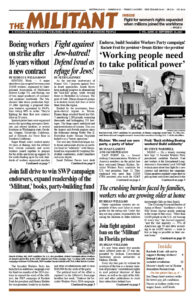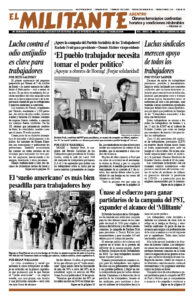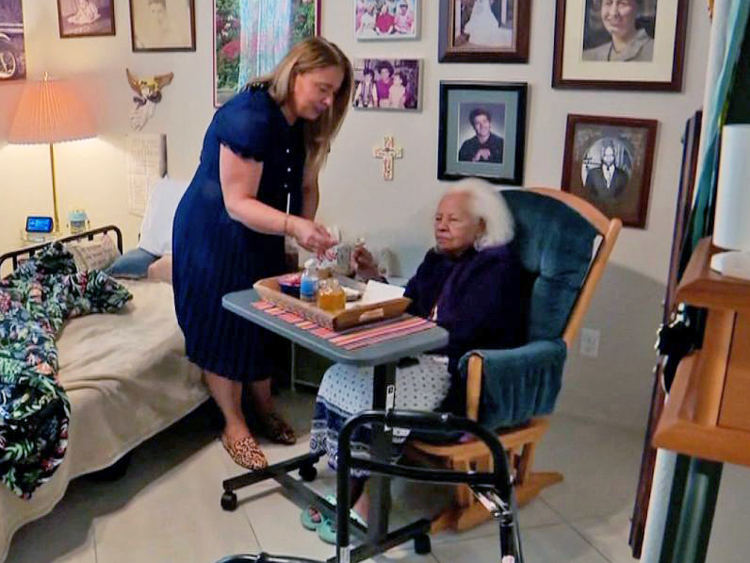Under capitalism workers are expendable if they can’t labor to create profits for the ruling rich. Under this dog-eat-dog system, responsibility for caring for children or older relatives increasingly falls on their family.
“The Crushing Financial Burden of Aging at Home,” headlined a Sept. 4 Wall Street Journal article, pointing to the scope of this crisis. “More than 11,000 people in the U.S. are turning 65 every day,” the Journal reported, “and the vast majority — 77% of Americans age 50 and older according to an AARP survey — want to live as long as possible in their current home.”
Most aging workers are all too familiar with the experiences relatives and friends have faced with neglect and inadequate care at profit-thirsty nursing homes and assisted-living facilities.
The government takes virtually no responsibility for care of elder workers. In recent years the cost of paid in-home care has soared. Those needing such care round-the-clock face a median annual cost of $290,000. About one-third of retirees don’t have the resources for any real length of minimal care. Some 90% of adults 65 and older have no long-term-care insurance.
Coping with this reality is driving more families to ruin. Five years ago Traci Lamb, newly divorced and without children, left her job and moved in with her parents to help her mother through knee-replacement surgery. “Then I was going to get my own place,” she told the Journal, but “things happened.”
The surgery left her mother with more pain than before, and her physical and mental condition got worse. Her father, with congestive heart failure and pulmonary disease, died in 2022. Unable to pay rent on their home, Lamb and her mother moved into a trailer, where she slept on an air mattress so her mom could have a bed.
In July her mother was diagnosed with Parkinson’s and dementia. Lamb left her job to have more time to care for her. To cover costs, she got two part-time jobs, including delivering food for DoorDash.
The Journal describes a number of similar stories.
Pharma, insurers jump on cash cow
At the same time, giant pharmaceutical companies charge up to a million dollars or more for a one-year supply of new medications developed to treat forms of cancer and other serious illnesses.
Danyelza, which treats neuroblastoma in the bone or bone marrow of pediatric and adult patients, costs $1,011,882 a year; Kimmtrak, used to treat uveal melanoma, a form of eye cancer, costs $975,520; Folotyn, which treats peripheral T-cell lymphoma, a rare blood cancer, costs $842,585; and Blincyto, used to treat a rare form of leukemia, costs $754,720.
Most insurance firms balk at covering these drugs.
At the same time they have a new money-making scam — convincing millions of Medicare Advantage patients they need to have medical tests at home that enable insurance giants, including UnitedHealth, Humana and CVS/Aetna, to boost profits.
“Insurers received nearly $50 billion in payments from 2019 to 2021,” the Journal reported Aug. 4, for tests and treatment they promoted “for conditions that no doctor or hospital treated. Many of the insurer-driven diagnoses were outright wrong or highly questionable.”
Medicare paid UnitedHealth about $2,735 for each of these home visits over the three-year span. Insurance call centers bombarded Medicare recipients with special offers like Walmart gift cards if they agreed to the visits.
One common test was to send a nurse to warm up the big toes of patients, supposedly to check for peripheral artery disease, a narrowing of the blood vessels.
Dr. Amy Chappell, a 73-year-old neurologist in Naples, Florida, was pressed by UnitedHealth to get the test. There was “no reason to think I had peripheral artery disease,” Chappell told the Journal, saying she had no symptoms and is an avid runner and tennis player.
She did take the test, and the insurance company said it was positive. But she decided to consult her primary-care doctor, who told her the diagnosis was inaccurate. Then the company admitted there had been a “mistake.”
Buying a house — a dream of millions of workers — is another example of the class divisions rife in capitalist society. If you’re wealthy you can shell out millions to buy property, and more and more of the well-heeled are doing so today. Papers like the Journal are full of ads for pads costing tens of millions.
In the Jacksonville, Florida, metro area, there was a roughly 12.6% year-over-year decline in the number of “nonluxury” homes sold in the second quarter, brokerage firm Redfin reported. Over the same period it reported a 20.9% increase in sales of “luxury” homes.
Changing these conditions will take working people in their millions organizing to take political power out of the hands of the capitalist rulers to meet the social needs and respect the dignity of every individual regardless of one’s age or condition — a socialist society.


